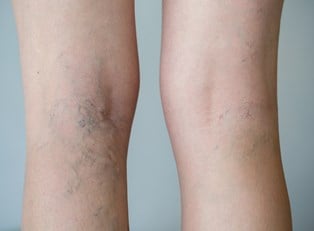Spider veins are particularly visible veins that occur near the surface of the skin when blood begins to back up and collect in them. While they will vary from person to person, they commonly take on a reddish or bluish hue and fan out in intricate patterns—similar to the patterns found in a spider’s web. While not life-threatening, spider veins can prove to be a nuisance, both cosmetically and physically.
Here is a short look at this condition—including what causes it, its symptoms, how it can be treated, and how it can be prevented.
Spider Vein Causes
The exact cause of spider veins is still unknown, but there are several risk factors that can help indicate a patient’s likelihood of developing them. These include:
- Gender: Women are more likely than men to develop the condition.
- Age: The risk of developing spider veins increases as a person gets older.
- Occupation: People who spend large amounts of time on their feet every day have a higher risk of spider veins. Careers in fields such as food service, retail, or nursing can exacerbate the problem, since they require so much standing.
- Weight: Excess pressure on the legs may be partially responsible for the development of spider veins. People who are overweight or obese have a higher chance of developing them.
- Heredity: People with a family history of spider veins are more likely to develop them than those who don’t.
Spider Vein Symptoms
Luckily, spider veins are not a particularly dangerous or pressing condition. However, this doesn’t mean that patients won’t experience some negative symptoms. Most commonly, this includes cramps or an aching sensation in the area of the legs affected by spider veins. In particularly severe cases, patients may experience a burning or tingling sensation as well. While less common, it’s also possible for swelling or ulcers to develop near the ankles. Finally, spider veins may become inflamed, which can lead to potential blood clots.
Women dealing with spider veins may find that their symptoms worsen during pregnancy or surrounding their menstrual cycle.
Spider Vein Treatments
Thankfully, there are a number of different treatments for dealing with spider veins—many of which are non-invasive and quite affordable.
The most common first course of action for dealing with them is compression stockings. These specialized support hose place pressure on the legs, which reduces the size of veins and thereby increases blood flow through them. In most cases, compression stockings are available over-the-counter at pharmacies and retail stores, but doctors can also prescribe them if the condition is particularly severe.
Spider veins can also be treated by patients who address the underlying causes of them. For example, weight loss may be able to help reduce the signs and symptoms of this condition, since excess body weight is a risk factor for development.
Sclerotherapy is another option for dealing with spider veins and involves patients receiving saline injections over a period of one to two months. As the treatment progresses, the condition will gradually start to disappear. While it is technically a medical procedure, sclerotherapy is usually quite affordable and is relatively non-invasive.
In severe cases, surgery may be necessary, but most doctors will only recommend this as a last resort. With this method, veins are either tied shut or removed entirely through small incisions in the legs. Surgery will require some form of anesthesia, but most patients are still able to return home on the day of their procedure.
Preventing Spider Veins
While people are unable to control every risk factor associated with spider veins, there are some lifestyle changes that can reduce the chances of developing them as much as possible. These include things like maintaining an active lifestyle and healthy weight, avoiding tight, form-fitting pants, and not sitting or standing for extended periods of time.



